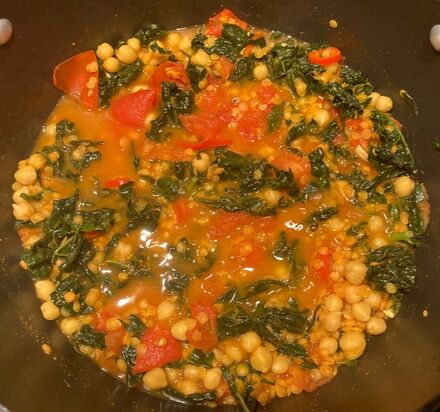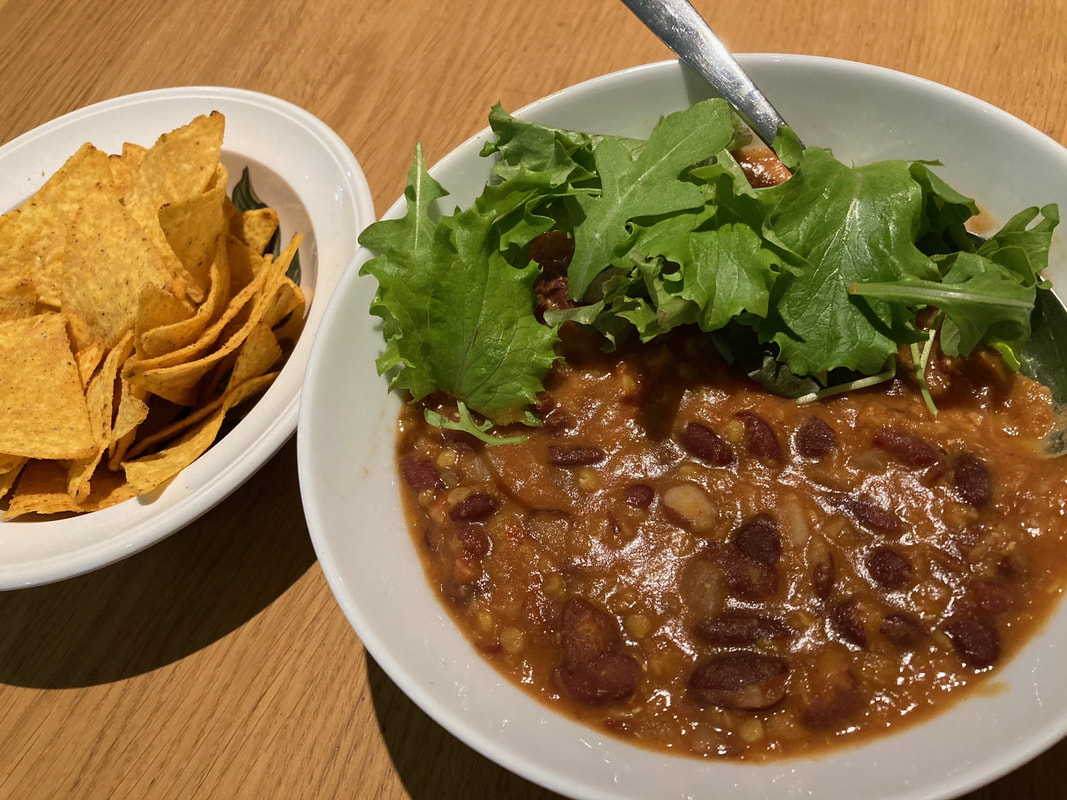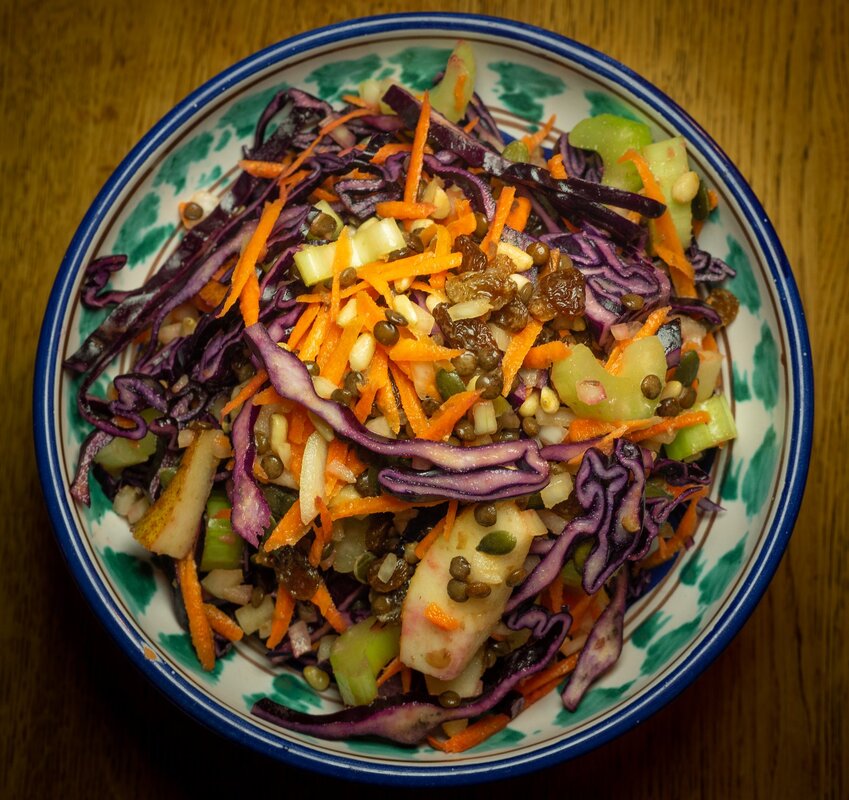|
I’m Neil Young, an exercise and healthy lifestyles specialist based in the Surrey Hills. Right now I’m working with For Earth’s Sake to bring some of the shop produce to life with delicious recipes that you can source entirely in store. I’m also adding on nutritional info and insights on the key ingredients. It’s January and these days that means that it’s Veganuary Season! For the last few years 100,000s of people have given up, or cut down on, meat, fish, and dairy for a month and switched to a plant-based, vegan diet. They might be doing this because they have heard that it is better for their health (it really is!), that livestock and dairy farming are responsible for more greenhouse gas emissions than all of the world’s transportation combined (they are!), or they are concerned about animal welfare (who wouldn’t be, right?). It has become a month when restaurants offer Veganuary menus and supermarkets push their plant-based meat alternatives. Familiar brands like Greggs, Ginsters, and Pukka Pies now have vegan versions of their popular products. These particular meat alternatives are good news for environmental sustainability and animal welfare, but, being calorie rich and nutrient poor, they’re not great for our health. Therefore, to help people to step into Veganuary in a healthy way, I am going to focus on a whole foods plant-based meal that is high in protein and contains a vast variety of the vitamins and minerals that you can only get from eating several different vegetables in the same dish. It’s a vegetable masala and, before we get to the recipe, I’m going to tackle the most common question that vegans are asked about their diet; where do you get your protein from? As well as being the most oft-asked question of people who follow a plant-based or vegan diet, it's also the one that irritates them the most! Why? Well, there are two common misconceptions about dietary protein. Firstly, the food industry would have us believe that we all need to eat more protein and they are adding protein to all sorts of products and passing them off as health foods (protein-enriched Mars Bar, anyone?). The truth of the matter is that most people eat more than the required amount of protein every day. In the UK the daily reference nutrient intake for protein is 0.75g per kg of body weight, which works out as 56g/day and 45g/day for men and women of average build, respectively. The actual average daily intake of dietary protein is 88g for men and 64g for women. The UK population is not protein deficient. The second misconception is that plant foods themselves don’t contain enough protein when compared to meat and dairy. While it’s true that meat, fish, eggs, and dairy products are higher in protein concentration than plant foods, plants do contain protein (where do you think cows get their protein from?), but they don’t have the high levels of saturated fats and cholesterol found in meat and dairy. That makes them a much healthier choice. Here are some of the most protein-dense examples of whole plant foods: Tempeh • Lentils • Edamame / Soybeans • Black Beans Tofu • Chickpeas* • Peas* • Hemp Seeds Peanut Butter* • Quinoa • Potatoes* • Almonds Rolled Oats • Broccoli* • Kale* • Kidney Beans * Featured in my vegetable masala recipe We can therefore meet all of our protein needs by eating plants, but there is one more thing to bear in mind - we should eat a wide variety of them. This is because protein is made from different combinations of amino acids, some of which can be produced in the body and some which can’t and have to be sourced from our diet. The ones which we have to get from our food are known as essential amino acids and there are 9 of them. Different plants contain different essential amino acids and no plant contains them all. To make sure that we are eating all 9 across the week we need to eat lots of different vegetables, grains, legumes, nuts, and seeds.  You can find out more about Neil Young and Healthy Life Neil by visiting healthylifeneil.co.uk or following Neil on Instagram @healthylifeneil. Vegetable Masala This recipe makes 6 servings. Ingredients
Method
Shopping List
1 Comment
I’m Neil Young, an exercise and healthy lifestyles specialist based in the Surrey Hills. Right now I’m working with For Earth’s Sake to bring some of the shop produce to life with delicious recipes that you can source entirely in store. I’m also adding on nutritional info and insights on the key ingredients. We hear plenty of talk of superfoods these days. Goji berries, matcha tea, chia seeds, beetroot, broccoli sprouts to name but a few. They can be bought in their natural form or processed into teas, powders, snack bars, and smoothies. These examples, and many more, are all very nutritious, but in the quest for discovering and promoting a new one-hit wonder we often overlook incredible food staples, which should form a high proportion of our regular meals and also have superfood qualities. The food that I am particularly thinking of is beans. The variety of choices is huge and beans are included in the cuisines of every different region of the world, from red kidney beans in Mexican chilli, white bean stews from across Europe, chickpeas in a Moroccan tagine, tofu in Japanese ramen noodles. They are undoubtedly tasty and filling, but what is the evidence about their health benefits and our quest to lose weight or keep it off? Well, one of the advantages that beans have over other starchy foods that we might crowd our plate with (bread, chips, pasta, rice), is that they are really high in fibre. This oft neglected nutrient holds one of the keys to weight management by making us feel full after meals without eating huge amounts of calories. In fact, increased fibre consumption has been shown to lead to a 10% drop in overall calorie intake. And it’s not just about calorie intake. By eating high fibre foods like beans we can stop the absorption of some of the calories from all food groups in a meal because these calories are literally wrapped up in the indigestible fibre so that they then pass straight through us. There’s one more weight loss-related advantage of increasing our dietary fibre through eating more beans that I want to highlight and it’s all to do with the signals that our gut sends to our brain when a meal is being digested. At the bottom of the small intestine (the ileum) there are sensors which can detect fats, carbohydrates and proteins in undigested food. If this happens, signals are sent to the brain to say that we are full and that we should stop eating. This phenomenon is called the ileal brake. High fibre foods (like my red bean and lentil chilli, below) slow the absorption of fats, carbohydrates and proteins higher up the intestines so that they are detected in the ileum and signals are sent to the brain to say, “You’re full. Stop eating”. When we eat low fibre, processed foods the calories are absorbed higher up in the intestine and never reach the ileal brake so we don’t get that signal to say that we are full up. I could go on and on about the benefits of high fibre bean cuisine all day (and I will in future!), but for now I think that it’s time for me to introduce you to my bean and lentil chilli recipe. This recipe is plant-based, and by adding lentils, nutritional yeast and onion powder you get the deep savoury flavours that you expect from any good chilli and there’s sweet corn too, for an extra crunch.  You can find out more about Neil Young and Healthy Life Neil by visiting healthylifeneil.co.uk or following Neil on Instagram @healthylifeneil. Red Bean and Lentil Chilli - Recipe This recipe will make 4 servings; enough for the whole family, but if you want to make a batch for the freezer, just double the amounts. Ingredients:
Method:
Shopping list:
All of the ingredients can be purchased from For Earth’s Sake. Each serving costs around £2.00. Here the list of what to add to your basket:
A great meal anytime though especially if you are looking at being a bit more healthy, a Meat-Free Monday dish or following Veganuary, this nutritious red cabbage salad with additional protein from seeds, pine nuts and lentils is a must. It has a zingy dressing and a distinctly crunchy bite. This serves two as a delicious and nutritious lunch. Ingredients For the salad 300g red cabbage, cored and shredded 2 large carrots, grated 1 medium onion, finely diced 1 pear (or apple), cored and sliced 2 celery sticks, sliced 100g dried puy lentils* (or 200g pre-cooked) 2 tbsp pine nuts 2 tbsp pumpkin seeds 2tbsp sultanas 1tbs liquid aminos / soy sauce (if using dried puy lentils)* For the dressing 1 tsp clear honey 1 tbsp lemon juice 1/2 tbsp olive oil Salt Pepper Method If using dried puy lentils, rinse the lentils in a sieve then place with 250g of water and the liquid aminos/soy sauce in a saucepan, bring to a boil then cover and simmer for fifteen minutes or until just al dente. The liquid should all have been absorbed by the lentils when cooked, if not drain the excess liquid away. If using tinned lentils tip them into a sieve and leave to drain for 30 minutes, discarding the excess liquid. Whilst the lentils are cooking/draining, prepare all the other ingredients, except the dressing, and add to a large bowl. Mix the dressing ingredients in a small bowl or cup, adding salt and pepper to your taste. When the lentils are cooked let then cool for ten minutes, stirring occasionally, then add the dressing and stir through thoroughly. Pour the lentil and dressing mix over the salad and toss until all ingredients are fully mixed and coated with the dressing. (Recipe by Richard & Paul for For Earth's Sake. Photo by Richard Leighton Hammond)
|
Archives
January 2024
Categories
All
|



